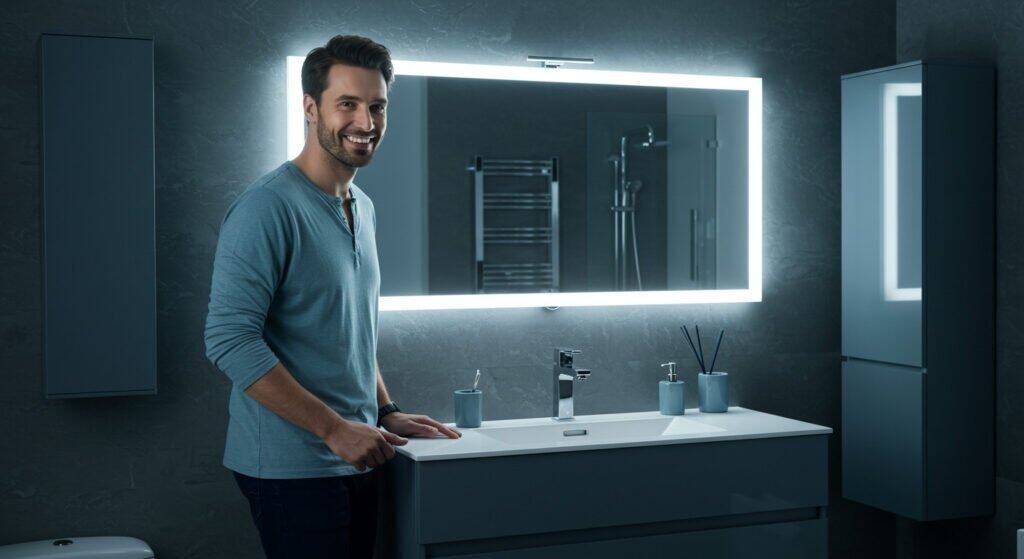Mirrors are everywhere. But have you ever thought about how many different mirror types there are?
The main types of mirrors include functional mirrors (plane, concave, convex), decorative mirrors (framed, artistic, antique), and modern utility mirrors like LED mirrors and backlit mirrors. Each serves specific purposes from basic reflection to advanced lighting integration for bathrooms, vanities, and commercial spaces.
Picking the right mirror can make a big difference. Keep reading to find out more.
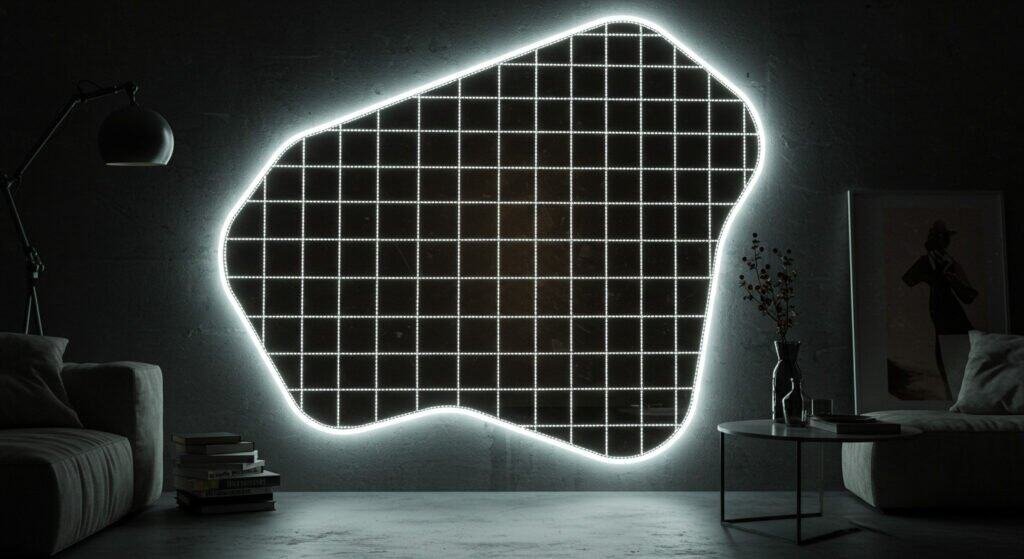
How Do Different Types of Mirrors Vary in Function and Design?
Mirrors aren’t just for looking at yourself. They can make an enormous
difference in a room.
Different mirrors serve different purposes. Bathroom mirrors often have lights and defoggers. Full-length mirrors let you see your whole outfit. Lighted makeup mirrors usually have magnification. Framed mirrors add style to your decor.
I’ve been exporting LED mirrors for 20 years. The reason I’m an expert is because with LED mirrors, it’s all about customization. For example, in the United States, maybe the light mirrors you need for the bathroom need to be waterproof and good lighting? Tony, must think about what sells well in the United States. My company has lots of modern lighted mirrors for bathrooms. Knowing the differences helps you make better decisions. You can do vanity mirror with LED lights, very popular. The different functions and designs change the price.
Here’s a table to break down the main types:
| Mirror Type | Common Features | Design Focus | Typical Use Case |
|---|---|---|---|
| Bathroom Mirror | LED lighting, defogger, touch controls | Clean lines, modern, moisture-resistant | Bathrooms |
| Full-Length Mirror | Large reflective surface, often with a stand or wall mount | Simple, functional, can be framed or frameless | Bedrooms, dressing rooms |
| Makeup Mirror | Magnification, adjustable lighting | Compact, portable, often with adjustable angles | Vanities, makeup tables |
| Framed Mirror | Decorative frame, various shapes and sizes | Wide range of styles, from classic to contemporary | Living rooms, hallways, entryways |
How Do You Choose the Right Mirror for Different Spaces?
To choose the right mirror, consider the room’s size, lighting, and style. A large mirror can make a small room feel bigger. A well-lit mirror is great for applying makeup. Match the frame to your decor for a cohesive look.
I’ve learned that different markets have different tastes. In South America, people might like bolder designs. In the Middle East, they might prefer more ornate frames.
What are the people in the United States buying? Research the trends. Because mirrors not only have a use, but are also decorative. I’ve seen some cool room mirror ideas online. Maybe there are some things I can do there. I mean, can’t even a small bathroom mirror have a big impact? Yes. What are the latest trends in modern bathroom mirror design?
Here’s how you might approach mirror selection for different rooms:
| Room | Considerations | Mirror Type Suggestions |
|---|---|---|
| Bathroom | Moisture resistance, lighting, size | LED bathroom mirror, framed mirror with defogger |
| Bedroom | Size, placement, style | Full-length mirror, dresser mirror, framed mirror |
| Living Room | Size, style, function as décor | Large decorative mirror, gallery wall of small mirrors |
| Entryway | Size, functionality (last-minute check before leaving) | Full-length mirror, console mirror |
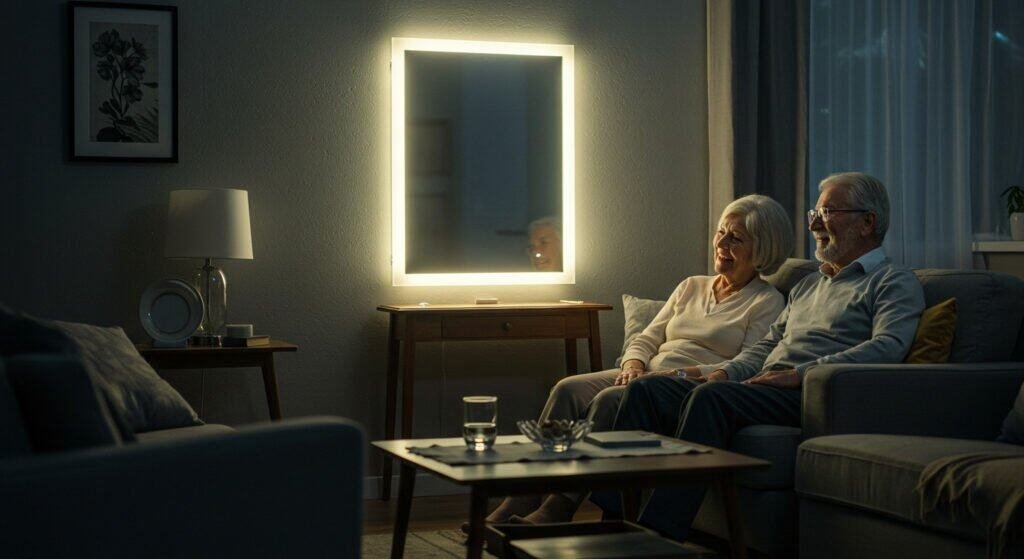
What Key Factors Should You Consider When Buying Mirrors?
Buying a mirror seems simple. But there are some important things to keep in mind.
When buying mirrors, consider quality, size, shape, and features. Check the glass mirror for imperfections. Make sure the size fits the space. Choose a shape that complements the room. Look for features like LED lighting or defogging.
As an exporter, I always stress the importance of quality. The glass should be clear and free of defects. The frame should be sturdy. The features should work reliably. You want to make sure you’re getting something that’s going to last. Customization is a huge benefit. Imagine if you could sell mirrors tailored to different shapes, sizes and features? That’s huge. A construction company may need a ton of basic, functional mirrors for a new apartment complex. An individual person might want a stylish, unique mirror for their home. Check to make sure the mirrors are types of mirror glass that meet safety standards.
Here’s a checklist of factors to consider:
| Factor | Details | Questions to Ask |
|---|---|---|
| Quality | Glass clarity, frame sturdiness, feature reliability | Is the glass free of defects? Is the frame durable? |
| Size & Shape | Fit with the space, complement the room’s design | Does the size fit the wall? Does the shape match the décor? |
| Features | LED lighting, defogging, Bluetooth, magnification | Do the features work well? Are they easy to use? |
| Customization | Options for size, shape, features | Can I customize the size and features? |
| Certification | Check if the mirror meets the import country’s certification standards | Do you have the necessary certificates? |
| Logistics | Package conditions and delivery time | How do you pack the mirrors? How long does it take to ship to America? |
| Payment Method | What is the method of payment? | What kind of payment methods do you support? |
What Are the 3 Main Types of Mirrors?
Mirrors come in different forms. But three types are most common. The three main types of mirrors are flat mirrors, concave mirrors, and convex mirrors. Flat mirrors are used every day. Concave mirrors magnify. Convex mirrors give a wide view.
These different types of mirrors have distinct properties and applications. This is a flat mirror, also knows as a plane mirror. It provides a true-tosize reflection. These are the ones you see all over the place. There is also a concave mirror. You’ve probably seen these before. They curve in. These mirrors magnify objects, making them ideal as a makeup mirror or for shaving. Then there’s a convex mirror. You’ve seen these in stores. You’ve seen them in the old, black and white movies. These curve outward. They provide a wide field of view and are used in security settings and as a car side mirror. From my experience, the LED light mirror vanity benefits greatly from understanding the reflection of different types of mirrors.
Here’s a simple breakdown:
| Mirror Type | Shape | Reflection | Common Uses |
|---|---|---|---|
| Flat | Flat surface | True to size | Everyday mirrors, bathroom mirrors |
| Concave | Curves inward | Magnified | Makeup mirrors, telescopes |
| Convex | Curves outward | Wide view | Security mirrors, car side mirrors |

What Are the 4 Rules of a Mirror?
Mirrors follow specific rules. These rules explain how they work. The four rules of a mirror involve reflection. These are: incident ray, reflected ray, normal, and angle equality. Light hits the mirror (incident ray), bounces off (reflected ray), and the angles are equal relative to the normal line.
These are the laws that govern how light interacts with mirrors. The incident ray is the light ray that strikes the mirror. The reflected ray is the light ray that bounces off. The normal is an imaginary line that is perpendicular to the mirror’s surface at the point of incidence. The angle of incidence (the angle between the incident ray and the normal) is always equal to the angle of reflection (the angle between the reflected ray and the normal). This principle is fundamental to understanding how mirrors create images. We need to know the principles of mirror typing to produce the perfect mirror.
Here’s a simple way to remember the rules:
- Incident Ray: Light going towards the mirror.
- Reflected Ray: Light bouncing off the mirror.
- Normal: Imaginary line at a 90-degree angle to the mirror.
- Angle Equality: The angle in equals the angle out.
What Is the Mirror Principle in Psychology?
Mirrors aren’t just physical. They also play a role in psychology. In psychology, the mirror principle means we see ourselves in others. We often project our own feelings onto people around us. This helps us understand ourselves better.
The mirror principle in psychology states that our connections with others are often mirrors of ourselves. It’s that we tend to project thoughts, feelings, and beliefs onto others. Then we see those projections as reflections of ourselves. Sometimes this shows up as attributing our motivations to others. We say, “Gosh, if I were this person, I know exactly what I’d be doing. So that’s what they must be doing.” Other times it shows up as measuring others against our own values. When we understand this principle, it helps us grow and understand our own psyche. It also helps us get along better with people This principle affects how people use light up vanity mirror and wall mirror with lights because they are trying to perfect their image.
Here’s a simplified view:
| Concept | Explanation | Example |
|---|---|---|
| Projection | Seeing your feelings in others | Assuming someone is angry because you are feeling irritable |
| Reflection | Others showing you aspects of yourself | Realizing you are impatient because someone else points it out |
| Understanding | Gaining insight into your own personality | Recognizing your own flaws through others’ behaviors |
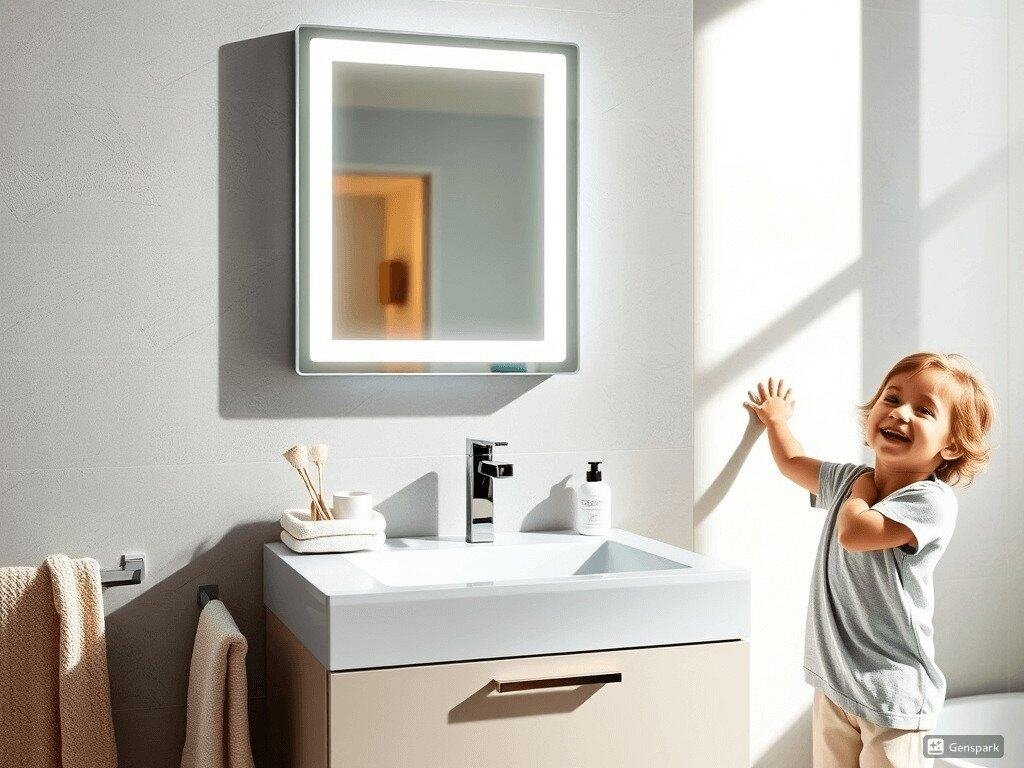
What Are the 2 Laws of a Mirror?
Mirrors follow scientific laws. These laws govern how light reflects. The two laws of reflection are: The incident ray, reflected ray, and normal all lie in the same plane, and the angle of incidence equals the angle of reflection. These laws explain how mirrors create clear images.
These laws govern how light works when it hits something that reflects. The first law says the incident ray, the reflected ray, and the normal (an imaginary line perpendicular to the surface at the point of incidence) all lie in the same plane. That means reflection happens in a two-dimensional world. The second law, as I mentioned before, says the angle of incidence is equal to the angle of reflection. This helps give you a good image of the object.
Here’s a simple breakdown of the two laws:
- Coplanarity: The incident ray, reflected ray, and normal are on the same plane.
- Angle Equality: The angle of incidence equals the angle of reflection.
Types of Mirror Glass
Common types of mirror glass include float glass, annealed glass, and tempered glass. Float glass is standard. Annealed glass is heated and cooled slowly. Tempered glass is stronger.
The mirror glass type significantly impacts the mirror’s durability, clarity, and safety. Float glass is the most common, and it gives you a smooth, clear reflection. Annealed glass is cooled slowly to relieve internal stresses, making it less likely to break. Tempered glass is heated to make it significantly stronger than annealed glass and is shatter-resistant, making it better for high-traffic areas or places where breakage might be a problem. An interesting side note is that if we were doing a backlit mirror project, we would need to pay attention to the light transmission rate of the glass.
Here’s a table summarizing the main types:
| Glass Type | Properties | Advantages | Disadvantages |
|---|---|---|---|
| Float Glass | Smooth, clear | Standard, cost-effective | More prone to breakage |
| Annealed | Reduced internal stress | Less prone to breakage than float glass | Still breakable |
| Tempered | Strong, shatter-resistant | Safer option | More expensive |
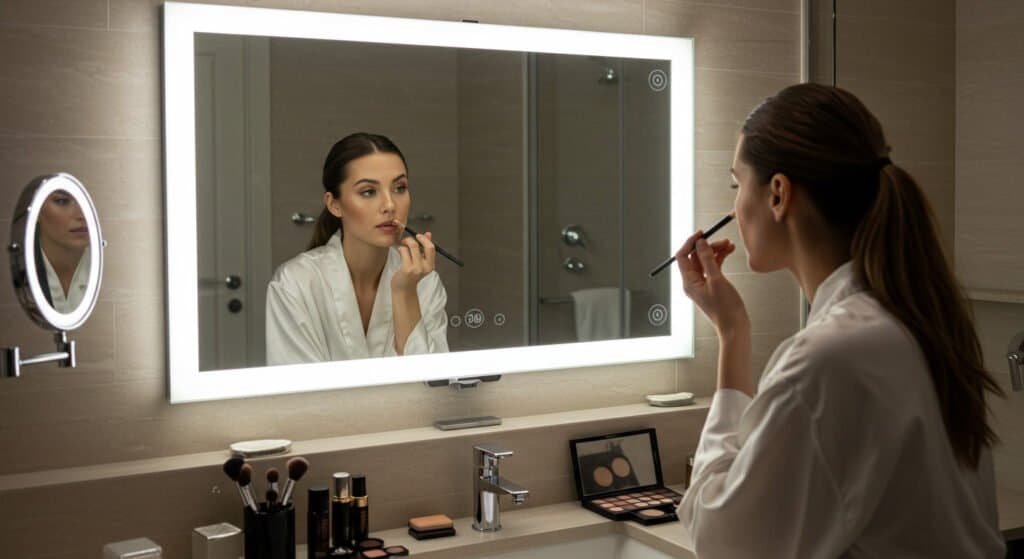
Are There Different Types of Mirror Glass?
Yes, there are different types of mirror glass. These include clear glass, tinted glass, and low-iron glass. Clear glass is standard. Tinted glass adds color. Low-iron glass provides better clarity.
The choice of mirror glass type affects the mirror’s appearance and performance. Tinted glass reflects with a color cast, which you can use to create a particular look. Low-iron glass has less iron oxide in it, so the reflection is clearer and more neutral. It works well in situations where color fidelity is important. Glasses mirror types can vary greatly in terms of clarity and color. From my point of view, a backlit mirror with low-iron glass can provide the best lighting effect.
Here’s a simple comparison:
| Glass Type | Appearance | Advantages | Disadvantages |
|---|---|---|---|
| Clear | Standard reflection | True-to-life color | Standard clarity |
| Tinted | Adds color | Aesthetic effect | May distort colors |
| Low-Iron | Clearer reflection | Enhanced clarity, accurate color reflection | More expensive |
What Are the 10 Examples of Convex Mirrors?
Convex mirrors are common. You see them in many places. Ten examples of mirrors that are convex include car side mirrors, security mirrors in stores, ATM mirrors, and some dental mirrors. They offer a wide field of view.
Use convex mirrors instead of flat mirrors to get a wider field of vision. That’s why they use them in cars as the side mirror. You can see more behind you to reduce blind spots. In stores, they use convex security mirrors to help cut down on shoplifting by allowing the staff to watch a larger area. The convex mirror also helps keep people safe at ATMs by allowing them to see what’s going on around them.
Here are ten common examples:
- Car side mirrors
- Security mirrors in stores
- ATM mirrors
- Dental mirrors
- Rearview mirrors in buses
- Mirrors in parking garages
- Mirrors at blind intersections
- Mirrors in warehouses
- Mirrors on forklifts
- Some makeup mirrors for a wider view

Convex Mirror Examples in Daily Life
Convex mirrors are useful every day. You probably see them without realizing it. Convex mirror examples in daily life include car mirrors, security mirrors in shops, and mirrors on buses. They help you see more around you.
Convex mirrors are a part of our daily lives because they help keep us safe and aware of our surroundings. The mirror in the car helps us see a wider view of traffic, reduces blind spots, and helps prevent accidents. The security mirror in the store helps to deter theft and gives the staff a wider view of everything in the store. The mirrors on the bus give the bus driver a view of what’s happening on their bus and around their bus. These are great examples of how convex mirrors are all around us. These examples of mirrors show how important it is to understand different mirror types.
Here are some more examples:
- Car mirrors: See more traffic.
- Security mirrors: Prevent theft.
- Bus mirrors: Monitor passengers.
- Warehouse mirrors: Avoid collisions.
- Blind intersection mirrors: See oncoming traffic.
How to Make a Mirror
Making a mirror seems like magic. But it’s based on science. To how to make a mirror, you need a clean glass surface, silver nitrate, reducing agents, and protective coatings. The silver nitrate coats the glass, creating a reflective surface.
Creating a mirror is a multistep process. First, you need to clean the glass surface incredibly well. The glass needs to be perfectly clean so the reflective coating will adhere to it. Second, you apply a solution of silver nitrate to the glass. Next, you introduce reducing agents that cause the silver ions to deposit onto the glass’s surface, thus forming a thin reflective layer of silver. Finally, you add a protective coating to the back of the silver layer such as copper or even paint to protect the silver from oxidation and scratching.
It’s fun to make a mirror, but it is a lot more fun to buy a professional mirror that will last forever. Here’s a simplified overview of the process:
- Clean the glass thoroughly.
- Apply silver nitrate solution.
- Add reducing agents to deposit silver.
- Apply a protective coating.

Conclusion
Choosing the right types of mirror involves considering function, space, and quality. From bathroom vanity mirrors to convex safety mirrors, a good choice enhances both your daily life and business value. I hope these examples of mirrors can help you better understand mirrors.
- Clik here to know What Is Copper Free Mirror?
- If you donot know how too choose the right bathroom height click here.
- Know more about LED bathroom mirror Problems
- Clik here to know why Touch Sensor Mirror Not Working
- Clik here to know What Are Standard Vanity Mirror Sizes?
- Clik here to know Why Are Mirrors So Expensive?
- Clik here to know Do LED Mirrors Need Electricity?
- Clik here to know Is a Lighted Mirror Enough Light for a Bathroom?
- Find out 10 Common LED Bathroom Mirror Problems Click Here

